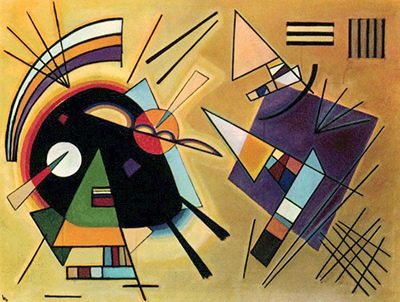 Buy Art Prints Now
Buy Art Prints Nowfrom Amazon
* As an Amazon Associate, and partner with Google Adsense and Ezoic, I earn from qualifying purchases.
Black and Violet is an abstract made by Russian artist Wassily Kandinsky in 1923. It's oil on canvas and measures 30.6 × 39.5" (77.8 × 100.4 cm). It is currently not being displayed and remains in a private collection.
Kandinsky was born December 16, 1866, in Moscow. His middle-class family was very multicultural. His father was born near Mongolia, his mother was a Muscovite, and one of his grandmothers hailed from the Baltic. He spent most of his childhood in Odessa, where he was known to be sensitive toward sounds, words, and colours. His family supported his many gifts and enrolled him in numerous music classes.
Despite his natural aptitude, he enrolled at the University of Moscow in 1886, majoring in law, and all told being very successful in that capacity. He would not begin painting until his 30's when Kandinsky was chosen to be a Professor of the Department of Law, a position he turned down, in order to live his dream and paint.
He left Moscow about 1889 and travelled the north-west of Russia, near the region of Vologda. There, in 1903, he met one of the great loves of his life... which did not fare well with his wife, Anna Chimyakina, whom he shortly divorced. The new lady of his life, Gabriela Munter, was an artist in her own right, and they spent the next five years galavanting around Europe, painting and displaying their works.
By the 1920s, Kandinsky had left Gabriela and moved on to Nina Andreevskaya, marrying her in 1917. Her father being a Russian General, they settled into the new wave artistic atmosphere that was now sweeping Moscow. It was in this post-revolutionary culture that he created what some critics have called his greatest work, Black and Violet.
Common to the period of the time, his works carry titles that communicate the main form or colour, or a combination thereof. This would keep from giving the viewer any mental pre-bias. Black and Violet, for example, is named after the two largest areas on the canvas. One can see three sailboats, two of them crossing calm water. The third, flying the Russian flag, is caught up in the darkness of the oncoming storm. Some believe that this painting reflects the artist's own chaotic relationship with Russia.
For Kandinsky, painting was an almost religious experience. He strived to show deep spirituality and human emotion through the use of abstract forms and colours. This, he felt, would transcend different languages and cultures, pulling at all mankind's heartstrings. In fact, Kandinsky considered himself a prophet, sharing ideals with the world to better society.
By the late 1930s, Kandinsky and Nina had moved to the suburbs of Paris, France. When the Germans invaded in the 1940s, the two of them fled to the Pyrenees, but returned swiftly after the war. He fell into a deep depression, feeling his works were not selling at their full potential. He died in France, on December 13, 1944 from cerebrovascular disease.
Although there is not many of his Russian works still available, his German creations are still surviving, and doing well at auction houses around the world. Some of his work has sold for well over $20 million.




